Here on Ryan Knighton's site, you'll find a wealth of material from one of the most moving and perceptive modern memoirists.
Canadian author Ryan Knighton has won the hearts of readers all around the world with his hilarious and frank accounts of life as a blind person. His first book, "Cockeyed: A Memoir," is about his experience of losing his sight in his twenties and relearning how to get around. Knighton guides readers with humour and insight through the highs and lows of his new existence, from learning his way about Vancouver to finding love.
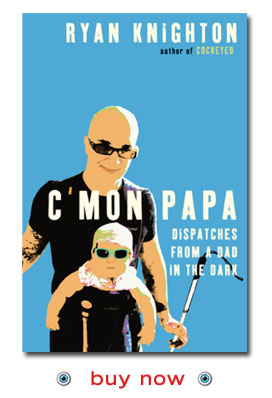
Knighton has continued to write and give talks regarding disability and accessibility issues since the release of "Cockeyed." His second book, "C'mon Papa: Dispatches from a Dad in the Dark," is a compilation of articles about his experiences as a father.
The wit, intellect, and compassion in Knighton's work have won him many fans. The Stephen Leacock Memorial Award for Humor is just one of many honors he has received; his writing has also been featured in The New York Times, The Guardian, and The Globe and Mail.
You may find a variety of information on Knighton's writing and lobbying activity on this site. You'll find plenty of intriguing and inspiring content here, whether you're a fan of his books or just interested in learning more about disability and accessibility concerns.
The website's blog is a standout feature because it's where Knighton discusses his many perspectives on issues of disability and accessibility. Knighton's blog covers a wide range of topics related to disability, from advice on getting around as a blind person to thoughts on the highs and lows of being a parent.
Knighton is not just an accomplished author, but also a sought-after speaker who has presented at events and conferences all over the world on the topics of accessibility and disability. His ability to relate to his listeners on a deeply personal level is a major factor in the success of his presentations.
You'll also find a wealth of details regarding Knighton's works here if that's your interest. This site has all you need to know about Knighton, from plot summaries and critic reviews to exclusive author interviews. You may get your hands on the latest must-read memoir with ease because you can buy it right from his website.
This site, however, is not merely for those interested in Knighton's works. You can also get information and assistance to help you, as a person with a disability, get around in the world and learn more about disability and accessibility concerns.
This website is a great resource for anyone looking to learn more about disability issues, whether they are living with a handicap themselves, have loved ones who do, or are simply curious about the topic. You'll discover all the information you need, from how to make your house more accessible to how to campaign for disability rights.
The goal of all of Ryan Knighton's writing and advocacy is to make the world a better place for people of all backgrounds and abilities. Knighton is constantly striving to make the world a more inclusive and accessible place for persons with disabilities through the sharing of his own experiences and the promotion of policy changes.
Check out Ryan Knighton's site if you're interested in finding out more about disability and accessibility difficulties, or if you're just looking for some creative motivation from one of today's most gifted authors. This website, with its helpful tools and interesting articles, is an excellent location to begin working toward a more accessible and welcoming society. Get involved right now and help make the world a better place for everyone by adding your voice to the discussion.
Knighton's writings share a central theme: the transformative potential of comedy.
Knighton has been blind his entire life, but that hasn't stopped him from keeping his sense of humor and his ability to find joy in life. His writing illuminates the challenges faced by people with disabilities while also being filled with humorous anecdotes and insightful observations.
But, Knighton's work is about more than just jokes. Empathy and comprehension are stressed as well. Knighton's work allows us to put ourselves in the shoes of those living with disabilities and have a better understanding of the difficulties they encounter on a daily basis. In doing so, he encourages us to feel more empathy and unity with the world around us.
This site is excellent for anyone interested in disability and accessibility concerns, whether they are already fans of Knighton's work or are just curious to learn more. If you're looking for something to move your heart and motivate you to make a difference in the world, go no further: this site has it all, from interesting articles to thought-provoking blog posts and a wealth of useful tools.
For checking out Ryan Knighton's webpage, I appreciate it. We trust you will find our site informative and look forward to your further engagement with us. If we work together, we can make the world a friendlier and safer place for all people.
How to Convert Your Home into a Safe Haven for the Blind – Secrets Revealed!
As a visually impaired individual, moving through an unfamiliar space can feel like attempting to unravel the complexities of a labyrinth with no guidance. Each step taken into uncharted territory is fraught with trepidation and uncertainty, as one must contend with the possibility of colliding against objects or obstructions in their path and the daunting prospect of going up the stairs without any visual cues. This daily struggle requires immense fortitude and resilience, for it necessitates that individuals living with blindness confront their fears head-on and persevere despite seemingly insurmountable obstacles blocking their way forward.
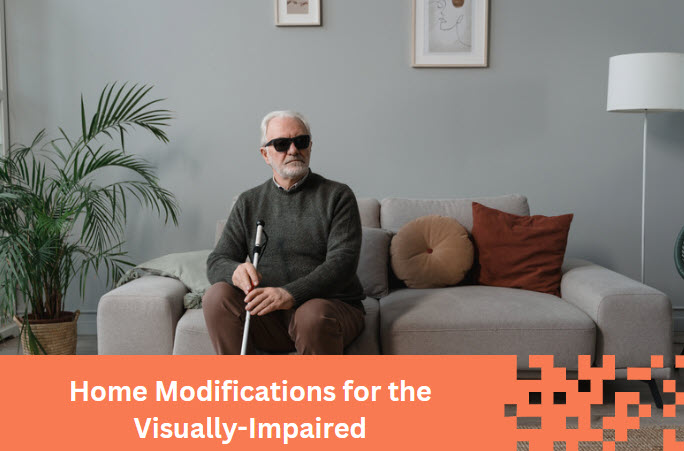
Imagine navigating through a dense forest at night with no light to guide your way. Each tree is a potential obstacle, similar to how furniture or other items might obstruct the path in an unfamiliar home. The forest floor could be uneven, much like unexpected steps or thresholds in a house, and overhanging branches can be compared to low-hanging light fixtures or other head-level obstacles.
The kitchen might feel like a chemistry lab, where one wrong move could lead to a dangerous situation – like mistaking acid for water, or in the home context, turning on a stove burner without realizing it.
Finding the bathroom in an unfamiliar home can be like looking for a hidden treasure chest on a vast, uncharted island. Even when you see it, there’s still the challenge of figuring out where everything is, like trying to unlock the treasure chest without the key.
Consistent organization, clear pathways, and assistive technologies can be crucial for blind individuals. It’s like providing a well-detailed map, a reliable flashlight, and a compass for that dense forest or uncharted island, making what could be a daunting and risky journey significantly more manageable and safer.
For this reason, using 3D visual representations in a medical setting or voice-controlled home automation technology could be seen as major advancements that can significantly improve the quality of life for blind individuals.
However, as stated in various studies and reports, only a small percentage of individuals with visual impairment have the proper training or access to these technologies. This leaves many individuals with visual impairment facing daily struggles when navigating the spaces in which they live. It is crucial to prioritize the accessibility and usability of assistive technologies, especially for those who could arguably benefit from them the most, such as individuals with speech and visual impairments. By providing easy access to assistive technology and its proper training, we can help alleviate the daily struggles that blind individuals may face when living at home.
Systematic Organization is Key
Living at home as a blind person can present daily struggles such as difficulties with navigation, object recognition, and social interaction. Navigating familiar spaces can be challenging as simple tasks such as finding the bathroom or kitchen might feel like searching for a treasure chest on an uncharted island.
For a blind person, a well-thought-out and systematic home organization is essential. Since vision is not available for navigation or locating items, other senses, and memory play a crucial role in day-to-day activities. Here are some of the most necessary modifications:
- Consistent Organization: Everything should have a designated place and be returned consistently. This allows the person to find items easily through memory.
- Clear Pathways: Pathways should be clear of clutter and objects that could cause trips or falls. This includes securing or removing rugs and securing any loose cables.
- Tactile Indicators: Tactile indicators can help identify different rooms, appliances, or items. This might include different textures on door handles or other types of flooring for different rooms. Braille labels can also be used.
- Technology: Assistive technologies can be extremely helpful, including talking clocks, timers, and appliances; voice-activated devices; and specialized computer and phone software.
- Safety in the Kitchen and Bathroom: These areas can pose particular challenges. In the kitchen, tactile markers on stove dials and other appliances can be helpful, as can organization systems for food and utensils. In the bathroom, consider installing grab bars around the toilet and in the shower or tub, and possibly a shower chair or bench.
- Sound Orientation: Using sound for orientation can be helpful. For example, a small water feature or clock in a room can provide an audio cue that helps navigation.
- Stair Safety: Handrails should be installed on both sides of metal staircases. Tactile or audio indicators can mark the top and bottom of stairs.
- Furniture: Furniture with rounded edges can prevent injuries, and furniture should be arranged consistently and not moved around.
- Doorways: To avoid bumping into open doors, it’s helpful to always fully open or fully close doors.
The key principle is creating a predictable and consistent environment that can be navigated through memory and other senses. It’s also important to involve the person living in the space in planning and decision-making to ensure the modifications meet their specific needs and preferences. An occupational therapist or a specialist in visual impairment can provide valuable guidance. Living at home as a blind person can present daily struggles, but many modifications and improvements can be made to create a safe and accessible environment. By implementing changes such as lighting, tactile indicators, assistive technology, safety measures in the kitchen and bathroom, sound orientation cues, handrails with proper height on stairs, furniture with rounded edges, and consistent doorways, it’s possible to create a home that is both safe and comfortable for people living with blindness. Assistive technologies can be extremely helpful for blind people at home, including talking clocks, timers, specialized software, and voice-activated devices to facilitate daily tasks.
It is important to create a comfortable and accessible environment for all people with disabilities living at home, with modifications based on their specific needs and preferences, like an assistive wheelchair ramp for people with mobility issues. Additionally, considering the Principles of Universal Design can help create a home environment that is accessible and intuitive for people with varying abilities. Living at home as a blind person poses unique challenges, but with careful planning and modifications, creating an environment that maximizes independence and safety is possible.

In this labyrinth of life, where light often fails to penetrate the dense canopy of the unknown, the visually impaired valiantly continue their journey. To them, an unfamiliar home feels like an intricate maze, a dense forest at night, or an uncharted island. Within these metaphors, we glimpse the enormity of their challenges – each piece of furniture or unexpected step becomes a towering tree in the dark, the kitchen morphs into a risky chemistry lab, and the simple task of locating a bathroom transforms into a treasure hunt on an expansive, unmarked island.
Yet, just as tools and knowledge can guide a traveler safely through a forest or aid in discovering hidden treasure, so can specific home modifications and assistive technologies illuminate the path for visually impaired individuals. By embracing systematic organization, clear pathways, tactile indicators, assistive technologies, and safety measures, we can transform the dense, unlit forest into a familiar park, the hazardous chemistry lab into a safe kitchen, and the vast, uncharted island into a comfortably navigable home.
However, these modifications are not a one-size-fits-all solution. Each person’s needs and preferences must guide the creation of a comfortable, accessible environment. We also must remember that access to these modifications and technologies is not universal. There is a dire need to democratize this access and provide necessary training to ensure that no one is left navigating their own home like a labyrinth in the dark.
In this effort, every individual, institution, and community holds a piece of the puzzle – the comprehensive solution to making all homes fully accessible and safe for those living with blindness. By piecing together this puzzle, we can offer a flashlight, a map, and a compass to our visually impaired friends and family members, making their journey through the labyrinth of life that much more manageable and their homes truly a safe haven.
Ryan Knighton’s DIY Home Improvement Hacks for the Visually Impaired
Author, journalist, and supporter of accessibility for the visually impaired, Ryan Knighton does it all. Knighton, who has been blind since he was 18, has overcome many challenges in his life, including those pertaining to house repair. In this post, we’ll look at some of the tools and equipment, planning and preparation, adjusting home features, and DIY projects that are suitable for visually impaired folks that Knighton recommends.
Accessibility for all people, regardless of ability, is why it’s crucial to discuss do-it-yourself home remodeling for the visually impaired. DIY projects may make homes more pleasant and accessible for people who are visually impaired if they have the necessary tools and adaptations.
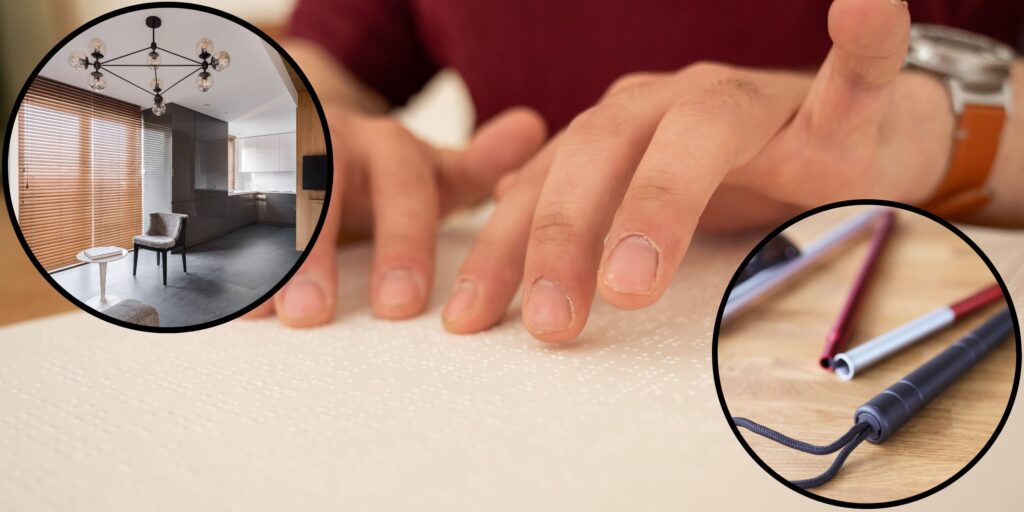
Hardware and Gadgets
Having the proper equipment is a must to beginning any do-it-yourself job. It may be required to modify tools so that they may be used by people with vision impairments. Talking tape measures and braille markings are only two examples of the kinds of built-in accommodations that may already be present in some instruments. Those with visual impairments can benefit greatly from these.
Unfortunately, such specialist equipment can be quite pricey. There are low-cost alternatives for people who are strapped for cash. Tool identification by touch, for instance, can be achieved by the use of tactile markers. Hammer and screwdriver handles can be made more manageable by dotting them with puff paint or hot glue.
Making plans and getting ready
DIY projects fail more often than they succeed because of poor planning and preparation. Visually challenged people can benefit greatly from tactile planning items and explicit vocal directions. Raised lines and textured materials can be used to create a tactile floor plan or diagram. To further ensure that people with visual impairments understand the procedure and can complete the project independently, it is helpful to include vocal instructions that describe the phases in detail.
It can be helpful to enlist the aid or support of loved ones or trusted advisors. Having someone else read aloud directions or assist with visually-demanding tasks like measuring and cutting are two examples.
Modifying Existing Structures
Visually impaired people can make their houses more pleasant and functional by modifying various components to increase accessibility. Light switches and thermostats can be marked with tactile indicators to aid the visually impaired in finding and using them. Using a bold hue to define door frames is just one example of how you may utilize color contrast to draw attention to specific parts of a room.
The addition of grab bars and handrails can help with movement, and motion-sensor lighting can make it easier to see in the dark. These modifications can be easy to implement, inexpensive, and highly beneficial to the quality of life for people who are blind or visually impaired.
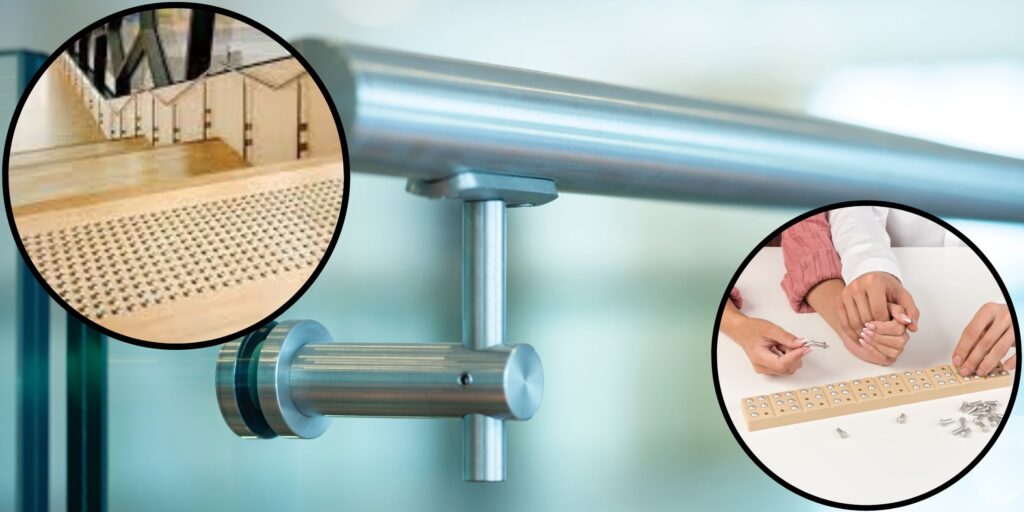
Do-It-Yourself Activities for the Blind and Visually Impaired
Several do-it-yourself tasks are accessible to those with vision impairments. There is a wide spectrum of complexity in these endeavors. Making a sensory garden is one way to accommodate the sensory needs of those with low eyesight. You can do this visually by adding plants with unique textures or scents, or aurally by setting up water features or wind chimes.
Putting up a handrail on a ramp or staircase is still another illustration. This easy-to-accomplish task requires only common household items and can significantly enhance home security and accessibility.
Always use caution when attempting a DIY project, and remember that it’s fine to ask for assistance or hire a professional if you get stuck.
Conclusion
In conclusion, tips on how the visually impaired might make their houses more accessible and comfortable are an essential topic. DIY projects can make a home more functional and pleasurable for the visually impaired if the correct tools, planning, and preparation are used. Putting accessibility first helps ensure that people of all abilities can enjoy the benefits of a shared area. For the visually handicapped who are considering attempting DIY projects, Ryan Knighton’s thoughts and expertise are invaluable resources.
To review, some of Knighton’s do-it-yourself home improvement hacks for the visually impaired include: using specialized tools or affordable adaptations to make tools more accessible; using tactile planning materials and detailed verbal instructions for planning and preparation; adapting home features for accessibility using tactile markings and color contrast; and tackling DIY projects that are well-suited for visually impaired individuals, such as creating a sensory garden or constructing an accessible ramp.
DIY projects may make homes more accessible and comfortable for people with visual impairments, and this confidence should be encouraged. Overcoming the obstacles of low eyesight and making a personalized environment is doable with the correct resources, preparation, and assistance. We can make the world a better place for everyone if we commit to making our homes more accessible to those with physical limitations.
Discover the Inspiring World of Ryan Knighton: A Memoirist and Advocate for Disability Rights
To say that Ryan Knighton has left an indelible mark on the field of disability rights is an understatement. Knighton’s commitment to making the world more accessible for people with disabilities, combined with the honesty and humor of his writing, have made him an inspiration to people all over the world.
Learn more about the motivational world of Ryan Knighton as we explore his memoirs, advocacy work, public speaking, and blog in this article.
Memoirs by Knighton
Knighton’s first book, “Cockeyed: A Memoir,” is a memoir about his experience losing his sight in his late twenties and learning to use his other senses to get around. This book delves deep into the experience of having a disability, and it does it with wit and heart.
Knighton’s internal conflict over his identity as a blind man is central to “Cockeyed.” He discusses the difficulties of using public transportation, securing steady job, and forming close relationships with others in his writing. He has a good sense of humor, however, and his writing is replete with astute observations and pithy expressions as he faces each obstacle.
Knighton’s unwavering sense of optimism and fortitude throughout “Cockeyed” is awe-inspiring. His writing inspires readers to broaden their perspectives and consider everyone, regardless of physical limitations, as valuable and worthy.
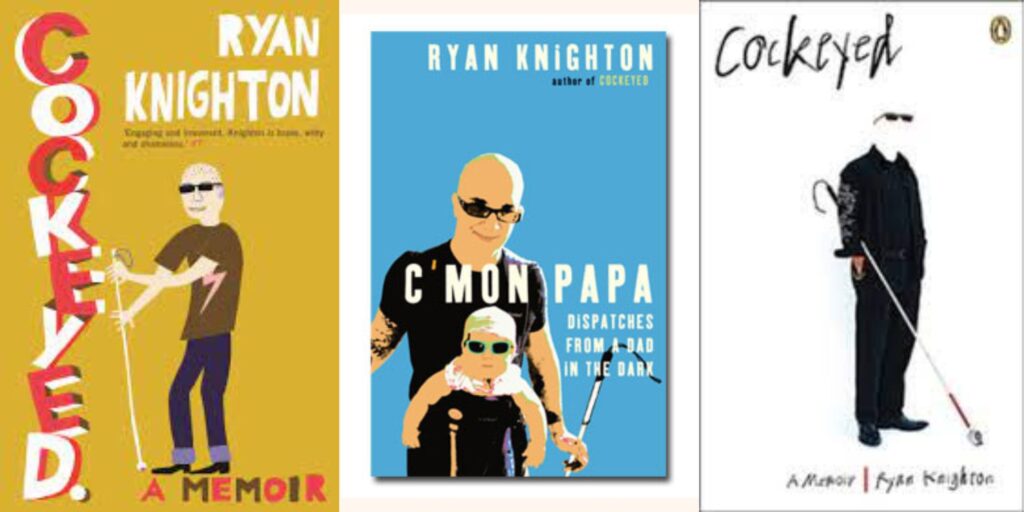
Knighton’s Efforts in Advocacy
Knighton is an avid supporter of disability rights and accessibility concerns in addition to authoring autobiographies. He has relentlessly promoted accessibility and inclusion in all facets of society for people with disabilities through his participation in a wide variety of organizations and activities.
Knighton’s attempts to promote the value of accessible design are emblematic of his advocacy work. He has written and lectured at length about the importance of designing accessible buildings, public spaces, and digital platforms. His efforts in this field have increased awareness of accessibility issues and motivated many people to join the battle for greater inclusion and accessibility.
The Novel #2 by Knighton
C’mon Papa: Dispatches from a Dad in the Dark, Knighton’s second book, is a compilation of writings about his experiences as a father. This book is a monument to the strength of love and perseverance, and it’s full of amusing and heartwarming stories about raising a blind boy.
Knighton’s “C’mon Papa” examines the difficulties of parenting with his signature humour and wisdom. He finds significance and delight in the most routine aspects of fatherhood, such as changing diapers and teaching his kid to play catch. Knighton, via his words, reminds us of the value of loved ones and the power of relationships above physical limitations.
Events Where Knighton Will Be Speaking
Knighton is an in-demand speaker on topics related to disability and accessibility, and has presented at events and conferences all over the world. His ability to relate to his listeners on a deeply personal level is a major factor in the success of his presentations.
Knighton’s ability to use comedy to disarm an audience and forge bonds is a key aspect of his speaking style. His humorous presentations leave his listeners feeling educated and motivated by his thoughtful teachings on disability and accessibility.
Web Log by Knighton
In addition to his book and public speaking, Knighton writes and speaks frequently on the topic of accessibility and disabilities. The blog’s posts span from the author’s personal experiences living with blindness to musings on the need of advocating for people with disabilities.
Knighton’s blog stands out from the crowd because of his hilarious and informative take on disability-related topics. He simplifies difficult concepts so that people of different educational levels and interests can enjoy them. His work is typically humorous and irreverent, yet it often provokes serious contemplation and has profound meaning.
Knighton’s blog covers a wide range of issues, including advice for navigating the world as a blind person, thoughts on the trials and tribulations of parenthood, and analysis of the current developments in disability rights activism and policy. His writings on disability and accessibility are usually approachable and readable, making them a great resource for anyone concerned with these topics.
Conclusion
It would be impossible to overestimate Ryan Knighton’s influence on the field of disability rights as a writer, campaigner, and public speaker. His writings and activism have encouraged many readers to broaden their perspectives and value every person for who they are, regardless of their physical or mental capabilities.
Knighton always offers a fresh perspective and a sense of humor to his work, whether he is writing about his personal experiences as a blind person, pushing for better accessibility and inclusion in all sectors of life, or interacting with audiences through his talks and blog.
There is a wealth of information on Ryan Knighton and his work that can be found online. You can read his blog posts and hear him talk by checking out his books, “Cockeyed: A Memoir” and “C’mon Papa: Dispatches from a Dad in the Dark.” The more you learn about Ryan Knighton and his amazing life, the more you’ll value accessibility and inclusiveness, and the more you’ll want to make a difference in the world.